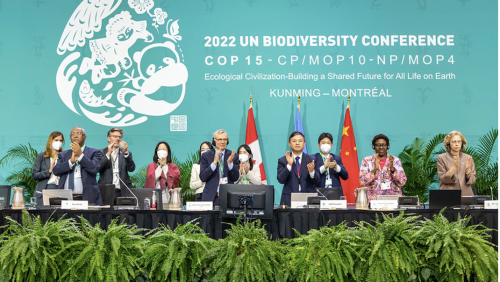A Win for Wildlife: The COP-15 Global Biodiversity Framework
January 23, 2023 by Amandine Fromont

A panel of people at a long table clap while standing in front of the COP15 Logo. Source: https://www.cbd.int/article/cop15-cbd-press-release-final-19dec2022
From December 7 to 19, 2022, the Convention on Biological Diversity (CBD) held its fifteenth Conference of the Parties (COP15), culminating in the Kunming-Montréal Global Biodiversity Framework.[1] The Convention on Biological Diversity is an international environmental treaty.[2] Established in 1992, it aims to conserve biodiversity, promote its sustainable use, and fairly and equitably share the benefits of genetic resources.[3] As of today, 196 countries have ratified it. While the United States has not ratified the treaty, and is the only UN member not to have done so, it also actively participated in COP15.[4]
The Conference of the Parties (COP) governs the Convention and has met every two years since 2000 to implement its targets and evaluate progress.[5] While COP15 was originally planned for 2020, it was delayed due to the COVID-19 pandemic and occurred in two phases: one virtually in October 2021, and the other in Montreal in December 2022.[6]
While negotiations were often tense over the two-week COP in Montreal, parties eventually agreed to adopt the Kunming-Montréal Global Biodiversity Framework. This agreement could mark a historical next step in biodiversity conservation, as it targets not only biodiversity loss, but also indigenous rights and ecosystem restoration.[7] It also comes at a critical time to establish new decadal targets for 2030 after the world’s overall failure to meet the biodiversity targets the Convention had set for 2020.[8] The Convention established these goals, known as the Aichi targets, during the 2010 COP-10 in Nagoya, Japan. These targets prompted some progress on biodiversity values at the national level, but were collectively not achieved according to a 2020 CBD Report.[9] Parties at this COP15 therefore faced significant pressure to reach an ambitious yet workable agreement that all member states could support. Further difficulties emerged from the parties’ differing priorities, as developed countries pushed for more ambitious biodiversity goals while developing countries emphasized the sharing of sufficient resources to allow them to achieve whatever goals emerged from this COP.[10]
COP-15’s final Global Biodiversity Framework (GBF) contains four major goals and twenty-three targets to achieve by 2030.[11] The broad goals include: (1) working to prevent species’ extinction; (2) promoting “sustainable use and management of biodiversity”; (3) achieving “fair sharing of the benefits from the utilization of genetic resources”; and (4) ensuring “that adequate means of implementing the GBF be accessible to all Parties.”[12] Within these goals, the twenty-three targets offer more specific and quantifiable aims on which parties can track their progress. These include the ambitious “30×30” targets: conserving 30% of the world’s land and 30% of its oceans by 2030.[13] Parties also approved another “30×30” target: raising $30 billion by 2030 to support developing countries and small island states.[14]
While these concrete targets could mark significant progress on protecting biodiversity, the United Nations Environment Program’s Executive Director, Inger Anderson, cautioned that establishing this Framework is only a first step.[15] Actually achieving the targets and goals will only be possible through focused and rapid implementation. For this reason, parties at COP15 approved a series of agreements along with the GBF related to monitoring and reporting of countries’ progress so as to ensure implementation gets prioritized.[16]
Overall, the new GBF represents an encouraging mentality: despite their disagreements, parties managed to collaborate and recognize the conservation of biodiversity as a critical priority for the coming decade.[17] Signing the GBF may also promote global interest in biodiversity and empower ordinary citizens to hold their governments accountable to meet these goals. In other words, it may be just what the world needs to achieve active conservation of biodiversity.
[1] UN Biodiversity Conference: COP15 in Montréal, Gov’t of Can., https://www.canada.ca/en/services/environment/wildlife-plants-species/biodiversity/cop15.html (last visited Jan. 19, 2023).
[2] COP15: Key Outcomes Agreed at the UN Biodiversity Conference in Montreal, CarbonBrief (Dec. 20, 2022), https://perma.cc/LZ4F-5MV4.
[3] Id.
[4] Id.
[5] Conference of the Parties, Convention on Biological Diversity, https://perma.cc/4CYP-KH8C (last visited Jan. 19, 2023).
[6] Id.
[7] CarbonBrief, supra note 2.
[8] Id.
[9] Secretariat of the Convention on Biological Diversity, Global Biodiversity Outlook 5 at 10 (2020), https://perma.cc/9JL8-RTR7.
[10] CarbonBrief, supra note 2.
[11] COP15 Ends with Landmark Biodiversity Agreement, UNEP, https://perma.cc/AH8G-AVQM (last visited Jan. 19, 2023).
[12] Id.
[13] Id.
[14] Id.
[15] Id.
[16] Id.
[17] CarbonBrief, supra note 2.

